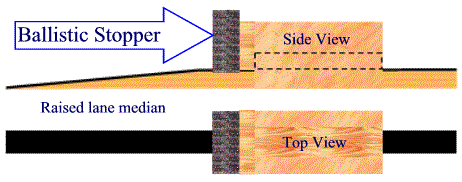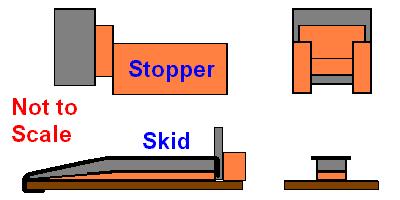The following is provided by Michael Lastufka, webmaster of the Grand Prix Racing website.
| He is to lay both hands on the head of the live goat and confess over it all the wickedness and rebellion of the Israelites--all their sins--and put them on the goat's head. He shall send the goat away into the desert in the care of a man appointed for the task. The goat will carry on itself all their sins to a solitary place; and the man shall release it in the desert. Leviticus 16:21, 22 |
In our years of pinewood racing, the worst thing that has happened was having wheels knocked loose and off because the stopper at the end of the race was a pillow! If a nice fluffy-soft pillow can do that, it must be playing with wheel alignment too - something not easily noticed until your car scrapes the lane median all the way down the track to finish last!
When we built our own track to conduct experiments and run our club races, we sorely wanted to find a better way! There is one. Stopping a car is about energy transfer. If the energy can be handed off, the car doesn't need to feel the full force of impact of even a pillow.

In the inevitable impact at the end of the race, a car must dump about 200 ozin of energy - more if it's the fastest. The force it experiences primarily depends on how far it travels when stopping.
The simplest model equation for stopping is:
Force = Energy / Distance.
If your car hits a brick wall, the distance taken to stop is essentially zero. Even if it bounces off, the force of impact approaches infinity! Your car is history or has been rearranged!
Let's say it stops in 1 inch, which is reasonable for a foam padded "wall". The force is then 200 / 1 = 200 ounces - that's 12.5 pounds! But if it bounces off as many do, the force can double - 25 pounds!
Let's say it stops in 3 inches which is reasonable for a pillow, though often the car is smothered to a stop rather than being met full front. 200/3 is about 67 ounces or four pounds. That's still more weight than I would want to set on my car.
For the ballistic stopper presented here, the car stops in about 6 inches. 200/6 is about 33 ounces or two pounds. That's half that of a pillow. In the future, we may be able to improve the ballistic stoppers even more so the car travels further with the stopper.
Materials
One stopper is needed for each lane.
| Sides | Two 3/4 x 5 x 2 1/2 inch pieces of wood. They may need to be narrower for your track. If so, try to make them the same weight therefore proportionally taller. |
| Center | 3/4 x 5 x 1 3/4 inch piece of wood |
| Bulkhead | 3/4 x 3 1/4 x 2 1/2 inch piece of wood |
| Impact pad | 1 1/2 x 3 1/4 x 3 inch piece of foam rubber |
| Glue / nails | Wood glue, hot glue and/or finishing nails |
| Rubber skid | 1 3/4 x 40 inch strip of old bicycle inner tube or equivalent |
| Skid padding | 1/2 x 36 x 1 3/8 inch strip of foam rubber |
| Skid median | 1/4 x 36 x 1 3/8 inch strip of wood |
| Baseboard | 38 inch long flat board to glue or nail the skids and backboard to. It must attach firmly to the end of your track. |
| Backboard | 1 3/4 x 1 3/4 x (width of base board) inch piece of wood (from a 2 by 2). It must attach firmly to the end of your baseboard. |
| Tools | A saw is needed to cut the wood parts in this list and to slope the skid median. |
Construction
For each lane of your track, construct one skid and one stopper. When a car hits it, the stopper slides on the skid which helps slow it down. The stopper is kept on the skid by the sides of the stopper. It often comes to rest against the back board. There is undoubtedly much that can be improved.
A Stopper
- Nail and/or glue the sides to the center piece. Raise the center 3/4 inch from the lower edge of the sides to make a short-legged "H" cross-section. The front edges must be flush.
- Nail and/or glue the bulkhead to the front of the growing assembly. The bottom edge of the bulkhead should be flush with the bottom of the center piece. The sides of the bulkhead should be flush with the sides of the stopper.
- Put hot glue over the front of the bulkhead and quickly press the foam pad on it. Quickly, assure that the bottom of the foam rubber is about a quarter inch below the bottom of the bulkhead so it is forced to rub the top of the skid harder. Otherwise, the pad covers the bulkhead with a little slopping over.

When constructed properly, the stopper skids across the skid rubber with its foam pad dragging. The little extra width of the rubber also helps slow the stopper as it is squeezed between the sides of the bumper. Each bumper weighs 9 ounces. To experiment with more weight, simply add baggies filled with sand to the back of the stopper.
A Skid
- Cut a slope in the skid median from zero height to 1/4 inch over the initial 12 inches.
- Measure placement and attach the skid median to the baseboard. The slope faces forward toward the track.
- Put hot glue on top of the skid median and roll out the foam strip over it while pressing with light pressure and an open hand. This avoids collapsing the foam into the hot glue - ruining it.
- Staple one end of the rubber strip under the baseboard in line with the skid median entry point.
- Stretch it carefully, but not real tight, over the entire skid to the other end.
- Staple the free end of the rubber strip to the back end of the skid median.
- Repeat the above steps until all medians are in place.
- Nail and/or glue the backboard just behind the skids as a final stopping line for the free-moving stoppers. If you like, pad the backboard with foam rubber so there is not as much noise in operation - clunk.
| Note: if the angle of the skid slope is too high, the cars become airborne if the stoppers are not set at the end of the slope! |
Use or Procedure
When a car enters the skid, the ramp causes its under-side to rub with some force on the rubber. The little extra width of the rubber pushes the wheels out some and helps keep the car centered on the skid. The car hits the stopper squarely on the foam pad without leaving the skid. Energy is transferred from the car to the foam pad. The pad absorbs some of the energy, but transfers most of it to the stopper.
The car stops in about 6 inches and the stopper skids to the backboard. Each stopper must be manually reset to the top of the skid slope each time a race is run.
| When resetting, make sure the foam pad is resting on the skid firmly. Cars with wedge-shapes noses can burrow between the skid and pad. Even this rarely results in damage, but it is a danger. |
Transfer of Energy
The transformation of energy of one kind to another or from one object to another is what makes our universe worth studying and why modern science can do so many useful things. We should not be surprised! God was in the transfer business long before He created the cosmos, not to mention during creation.
The verse at the top of this page was a demonstration to the Israelites of how God transfers and then carries away the sins of His people. It was also a prophetic glimpse of the most wonderful transfer of all - our sins to his Son, Jesus Christ, on the cross. Before Christ, the priest obediently laid his hands on the head of a special goat - the "scapegoat". Today, we obediently repent and give our lives to Jesus. When we do, He has taken our sins from us on the cross so we might be pure and acceptable to worship and fellowship with Him.
God's transfer of His grace, love, joy, peace, patience, kindness, goodness, faithfulness, gentleness, self-control and glory lasts an eternity!
Cast all your anxiety on him because he cares for you.
1 Peter 5:7
Copyright © by Michael Lastufka, All rights reserved worldwide.